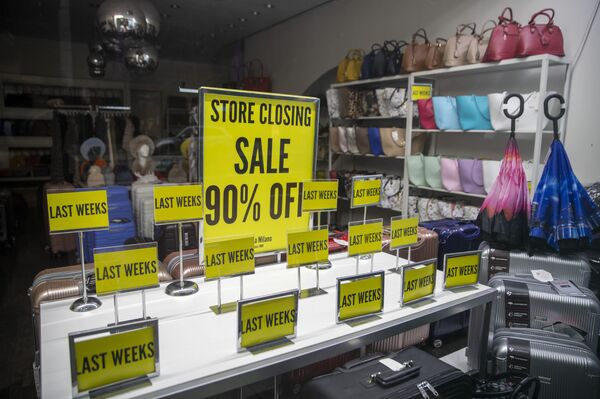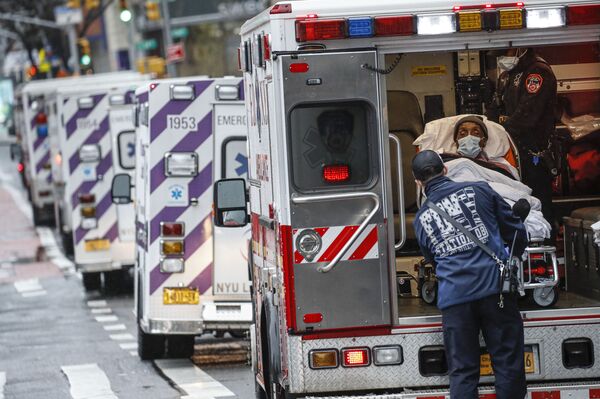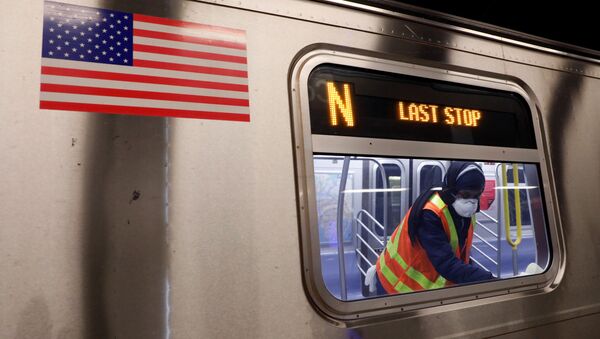“New York City is dead forever,” entrepreneur James Altucher proclaimed in a much-talked-about blog post on 14 August.
Altucher, who owns a stand-up comedy club in the Upper West Side, paints a picture of a city falling apart: emptying skyscrapers and apartments, Broadway in the dark, and – the horror – no more hot dog stands near Lincoln Center.
The fire-and-brimstone message has prompted quite a debate in metropolitan media (and a searing rebuke from diehard New Yorker Jerry Seinfeld), but it does reflect the valid concerns of many citizens affected by the COVID-19 pandemic.
The modern plague, which descended on Gotham on 1 March, has since infected 234,000 people in the city and killed more than 23,600. New York is one of the worst-affected areas in the United States.
How hard has it been hit?
The coronavirus is still raging, but it has already cost billions of dollars to New York alone. A months-long lockdown and a lack of federal aid forced one-third of local businesses (over 2,800) to close for good since the onset of the pandemic – more than in any other large American city. It isn’t clear how many of them will ever come back.
Business closures saw jobless rate quadruple from last year, reaching 19.8 percent in July. The soaring unemployment and fears of the virus – coupled with sometimes-violent racially charged protests – prompted many New Yorkers to relocate.
Though evictions are on hold until October, New York is the metropolitan area with the largest outflow of people in April-June, according to real estate site Redfin. More than a third of all house searchers by New Yorkers during that period were for destinations outside the virus-ravaged city.

Some moving companies report that their order book has grown by more than 46 percent year-on-year since the onset of the pandemic, and others are so busy they have to turn down new customers.
A record-high number of empty apartments and falling home values, along with decade-low rental rates and offers of up to 3 months of free rent, underscore the severity of the crisis and will most definitely send yields and investments crashing.
The crisis may have been alleviated with cash injections, if not for tax receipts falling by a whopping 27 percent. As a result, New York is currently facing a $9-billion budget deficit over the next two years. Austerity measures, translated into cuts to health and social services worth hundreds of millions of dollars, could further hurt the city’s reputation as a financial and cultural beacon.
“Not only does the city face the challenges that many other cities face, due to the reorganisation of the economy in a pandemic world, but it also faces the risk that in the near future young people from the US and the rest of the world will stay away from it, in fear of being infected and/or not [being] welcome,” says Nicola Borri, a Rome-based economics and finance professor.
The federal government does not appear to be an effective helper either: it forked out over just $1.4 billion for the city from its $2.2-trillion coronavirus aid package. This is just $200 million more than New York lost in tax collections from April to June. More federal funds hang in the balance as the next relief package has been tied up in the Senate.
Was it better before?
It is evident that New York will have the most difficult time bouncing back from the coronavirus pandemic. The unprecedented severity of the situation brings back memories of its darkest moments – the 11 September terror attacks and the 2008 economic collapse.
“This time is different,” reads Altucher’s the-glass-is-entirely-empty post. “You’re never supposed to say that but this time it’s true.”
It does seem that New York emerged from past calamities, however grave they were, more easily than expected.
The 9/11 attacks cumulatively cost New York between around $83 billion and $95 billion, according to local authorities (this includes lost earnings of workers, property damage, and lost GDP for three years after the towers fell). New York also had a 141,500-job shortfall the following year.
But clean-up work ended months ahead of schedule, and the federal government provided approximately $20 billion of assistance to the shattered metropolis through FEMA funds, urban development, construction and rebuilding of transport infrastructure, and tax benefits in lower Manhattan.
New York reached its pre-September 2001 GDP only in 2004. The speed of recovery was slow due to the recession that followed the dot-com bubble bust.
The 2008 financial collapse, riding on the tail end of a subprime mortgage crisis, was initially projected to have far more serious consequences.
Wall Street’s financial industry, one of New York’s biggest taxpayers, took a huge hit when all those banks and insurance companies started going bust.
The Great Recession’s unemployment rate in New York reached its peak of 10.4 percent in December 2009 and then started falling again. Again, this was due to federal stimulus measures that led to a stock market rebound and a drop in unemployment, The city’s GDP reached its pre-crisis levels in 2009 and has been on the rise ever since, just like the entire US economy.
What to expect?
Any future rebound or decline in economic activity in New York hinges heavily on how close a COVID-19 vaccine is, but there is always some room for guesstimates based on short-term fluctuations.
The city’s employment rate is showing signs of rebound, with jobless rate dropping in July to 19.8 percent – a decrease of 0.5 percent from June, but still well above the national average of 10.2% and the state’s rate of 15.9%.

Reservation app Resy estimates that New York restaurants are performing at around 23 percent of last year’s volume, a sign of progress from the 10 percent figure of mid-July. It seems that the earlier spike in out-of-city residence browsing has slowed down too.
Gregory Price, an economics and finance professor at the University of New Orleans, estimates that the economic impact of the pandemic on New York will last for “no more, if not less than, five years”.
He cites research by the firm Commercial Property Executive, which found that commercial property availability in downtown Manhattan took five years to recover, and a 2007 study by the Federal Reserve Bank of St. Louis, which pointed to a quick recovery from the Spanish Flu pandemic of 1918.
Much will depend now on whether city authorities will be able to keep the situation with the virus under control. The coronavirus positivity rate is currently hovering around 0.7 percent, and the similar statewide situation may provide a stimulus for people who have left New York for the suburbs and upstate to come back.
However, many workers who have left the city since March could choose to stay at their new location nonetheless because of the availability of remote work.
“Most of the richer in NYC are well educated and therefore understand the potential risks of Covid-19. They can also easily switch to work at home given their wealth and high-end jobs,” says Bo Chen, Research Associate at the Federal Reserve Bank of Dallas.
“This trend could result in a deeper recession in NYC as they demand much less in the city. However, such a recession is different from 9/11 and 2008 financial crisis. This time the richer would have to be out of town for quite a long time and maybe permanently in some cases.”
He says the previous two crises were widely seen as “temporary shocks” and did not create a long-term recession because the affluent people hadn’t left for good.

Christopher Bovis, professor of international business law at the University of Hull, predicts that the shift of working practices to remote and home-based will have a “seismic effect on labour markets” and put a test to employment regulations.
“New York is the prelude of economic change in the globe. Not only because of Wall Street and the services which support the financial engine of the USA, but mainly because of a culture of constant reliance on others in multiple networks which support the BIG Network,” he says.
“An initial assessment is that it will take a decade to revert back to the status of the beginning of 2020. That depends predominately on the development and availability of a vaccine and the speed of recovery from the relevant sectors.”
“New York offers a bleak view of the state the world's mega cities are in. New York will recover, but the cost will be nothing seen before, when compared to 9/11 and 2008 crises. If only a vaccine would turn up soon.”





